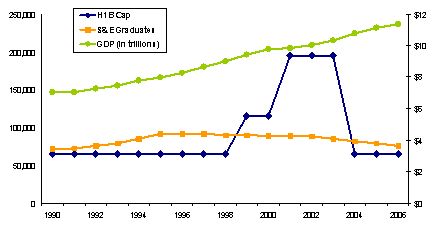

In 2007, the U.S. Citizen and Immigration Services announced that the H-1B visa quota for 2008 was oversubscribed by a factor of three in the first week after the quota was opened. This scenario was repeated with the 2009 H-1B quota, which was opened on April 1, 2008 and was oversubscribed in seven days. Why are companies doing everything they can to get a share of the annual H-1B quota of 65,000 skilled foreign workers? Are companies outsourcing the best paying jobs in America? Is it possible that American companies and their counterparts in the European Union are facing an emerging global race for talent?
The purpose of this brief commentary is to highlight the dynamics affecting the competition for talent, as researched by the Duke University Offshoring Research Network (ORN) project at the Fuqua School.
The key conclusions from the 2006 ORN report Next Generation Offshoring: The Globalization of Innovation1 were:
Subsequent research suggests the following dynamics at play. Before 2003, accessing Science and Engineering talent by American corporations primarily was driven by cost considerations. On average, H-1B hires cost employers less than equivalent U.S. employees. Moreover, H-1B employees were legally bound to the employer who received the quota and had no bargaining power to demand higher compensation. However, after 2003 the data show that attracting skilled science and engineering S&E foreign workers and/or locating S&E work in locations offshore was being justified primarily on the basis of the need to attract and retain talent anywhere in the world. Cost consideration issues became secondary.
As illustrated in the figure below, the number of U.S. nationals earning master’s and Ph.D. degrees from U.S. science and engineering schools has been declining steadily since 1995. At the same time, the number of foreign workers on an H-1B visa, the majority of whom were in S&E fields, increased between 1998 and 2003 from 65,000 to 195,000 annually. But in 2003, the U.S. Congress did not renew the H-1B visa quota at the 2002 level and the quota lapsed to pre-1998 levels, remaining constant at 65,000. The combined result of these is that in 2006, the number of S&E workers available to work in the U.S. was below the 1995 level. Additionally, the U.S. gross domestic product (GDP) increased by 43 percent between 1995 and 2006, suggesting a growing demand for and a possible shortage of S&E workers. According to economic theory, wages for S&E professionals should adjust upward to attract new individuals into S&E careers to the point where the imbalance between supply and demand will be corrected. However, because the S&E job market has morphed into a global market, the adjustment, if any, is likely to require much more time than when labor markets were largely nationally bound.
Shortage of S&E talent in The US and change in H-1B visa policy2

Data on Master and PhD degrees in sciences and engineering come from the US National Science Foundation.
Data for H-1B visa quota come from the US Citizenship and Immigration Services.
Companies now are able to access S&E workers globally to support their business, which reduces any upward pressure on S&E wages in the U.S. and may therefore delay possible market adjustment. However, this may not be the only dynamic at play. The growing shortage of S&E talent in the western economies may be the result of the confluence of other dynamics — an aging population; lack of adequate math and science preparation in high schools; a growing number of “techies” choosing to work as independent contractors; and structural changes in the engineering labor market toward employing engineers on demand also are likely contributing to this trend. Finally, countries like India and China are instituting aggressive policies and incentives to induce their nationals with advanced degrees in S&E fields to return to their home country.2, 3
The immediate effect that these dynamics have on companies is to experiment with and learn to globalize their innovation activities and to invent new global organization forms for all their activities. First, it was the outsourcing of manufacturing. This was followed by business process outsourcing (BPO) and information technology outsourcing (ITO). The third stage is the globalization of all activities, including innovation. The need to compete globally for S&E talent is forcing companies to reinvent their organizations through new product development, R&D and engineering services. Leading edge companies already are experimenting with decreasing the fixed cost of their engineering and R&D footprint (employment and laboratory space), while at the same time increasing the rate of new product development activities by modularizing and globalizing these activities. The forthcoming 2007/2008 ORN report will highlight these dynamics, the emerging new organization forms and the implications for American companies and the competitiveness of the U.S. economy.

